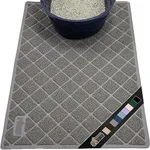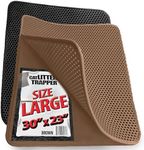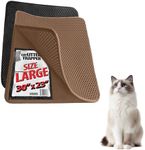Buying Guide for the Best Cat Litter Mats
Choosing the right cat litter mat can make a big difference in keeping your home clean and making life easier for both you and your cat. The main purpose of a cat litter mat is to catch litter that gets stuck to your cat’s paws as they leave the litter box, preventing it from being tracked all over your floors. When picking a mat, you’ll want to consider your cat’s habits, the type of litter you use, and how easy the mat is to clean. Understanding the key features will help you find a mat that fits your needs and keeps your space tidy.MaterialThe material of a cat litter mat affects how well it traps litter, how comfortable it is for your cat, and how easy it is to clean. Common materials include rubber, PVC, foam, and fabric. Rubber and PVC mats are durable, waterproof, and easy to shake or rinse off, making them great for most homes. Foam mats are softer and more comfortable for sensitive paws, but may not be as durable. Fabric mats can be cozy but might hold onto odors or be harder to clean. If your cat is picky about textures, choose a softer material; if you want something low-maintenance, go for rubber or PVC.
SizeThe size of the mat determines how much area it covers around the litter box and how much litter it can catch. Mats come in small, medium, and large sizes. Small mats are compact and fit in tight spaces, but may not catch as much litter. Medium mats offer a balance between coverage and space. Large mats provide the most coverage and are best if your cat tends to jump out of the box or if you have multiple cats. Consider the space you have and your cat’s behavior—if your cat is messy or you have more than one, a larger mat is usually better.
Texture and DesignThe texture and design of the mat help trap litter from your cat’s paws. Some mats have deep grooves, mesh, or honeycomb patterns that catch more litter, while others are smoother. Mats with deeper textures are more effective at trapping litter but may be harder to clean. Smoother mats are easier to wipe down but might not catch as much. If your cat is sensitive to textures, choose a mat with a gentler surface. If litter tracking is a big problem, look for mats with more pronounced patterns.
Ease of CleaningHow easy it is to clean the mat is important for keeping your home fresh and odor-free. Some mats can be shaken out, vacuumed, or rinsed with water, while others may need to be washed in a machine. Mats with removable layers or that can be folded make cleaning simpler. If you want minimal effort, pick a mat that can be quickly shaken or rinsed. If you’re concerned about odors or stains, look for mats that are machine washable or have antimicrobial properties.
Waterproof or Leakproof FeaturesWaterproof or leakproof mats prevent urine or spilled litter from seeping through to your floors. This is especially important if your cat sometimes misses the box or if you use a litter that can get wet and sticky. Some mats have a waterproof backing or are made entirely from water-resistant materials. If you have a kitten, an older cat, or a cat with accidents, a waterproof mat can help protect your floors and make cleanup easier.
Non-Slip BackingA non-slip backing keeps the mat in place, preventing it from sliding around when your cat steps on it. This is important for safety and for making sure the mat stays where it can catch the most litter. Mats without a non-slip backing may move around, making them less effective. If your litter box is on a smooth floor or your cat is energetic, look for a mat with a good grip on the bottom.















